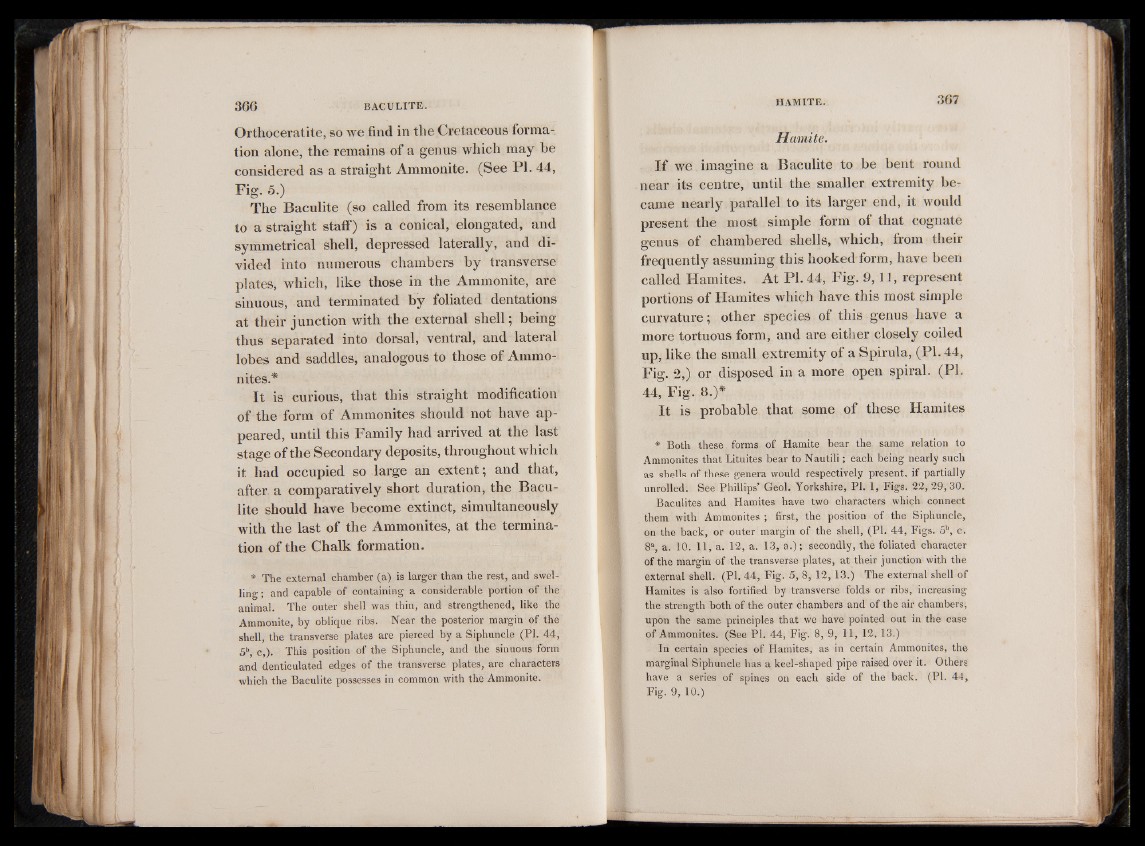
Orthoceratite, so we find in the Cretaceous formation
alone, the remains of a genus which may be
considered as a straight Ammonite. (See PI. 44,
Fig. 5.)
The Baculite (so called from its resemblance
to a straight staff) is a conical, elongated, and
symmetrical shell, depressed laterally, and divided
into numerous chambers by transverse
plates, which, like those in the Ammonite, are
sinuous, and terminated by foliated dentations
at their junction with the external shell; being
thus separated into dorsal, ventral, and lateral
lobes and saddles, analogous to those of Ammonites.*
It is curious, that this straight modification
of the form of Ammonites should not have appeared,
until this Family had arrived at the last
stage of the Secondary deposits, throughout which
it had occupied so large an extent; and that,
after a comparatively short duration, the Baculite
should have become extinct, simultaneously
with the last of the Ammonites, at the termination
of the Chalk formation.
* The external chamber (a) is larger than the rest, and swelling
; and capable of containing a considerable portion of the
animal. The outer shell was thin, and strengthened, like the
Ammonite, by oblique ribs. Near the posterior margin of the
shell, the transverse plates are pierced by a Siphuncle (PI. 44,
5b, c,). This position of the Siphuncle, and the sinuous form
and denticulated edges of the transverse plates, are characters
which the Baculite possesses in common with the Ammonite.
Hamite.
I f we imagine a Baculite to be bent round
near its centre, until the smaller extremity became
nearly parallel to its larger end, it would
present the most simple form of that cognate
genus of chambered shells, which, from their
frequently assuming this hooked form, have been
called Hamites. At PI. 44, Fig. 9, 11, represent
portions of Hamites which have this most simple
curvature; other species of this genus have a
more tortuous form, and are either closely coiled
up, like the small extremity of a Spirula, (PI. 44,
Fig. 2,) or disposed in a more open spiral. (PI.
44, Fig. 8.)*
It is probable that some of these Hamites
* Both these forms of Hamite bear the same relation to
Ammonites that Lituites bear to Nautili; each being nearly such
as shells of these genera would respectively present, if partially
unrolled. See Phillips’ Geol. Yorkshire, PI. 1, Figs. 2 2 ,2 9 ,3 0 .
Baculites and Hamites have two characters which connect
them with Ammonites ; first, the position of the Siphuncle,
on the back, or outer margin of the shell, (PI. 44, Figs. 5b, c.
8% a. 10. 11, a. 12, a. 13, a .); secondly, the foliated character
of the margin of the transverse plates, at their junction with the
external shell. (PI. 44, Fig. 5, 8, 1 2 ,1 3 .) The external shell of
Hamites is also fortified by transverse folds or ribs, increasing
the strength both of the outer chambers and of the air chambers,
upon the same principles that we have pointed out in the case
of Ammonites. (See PI. 44, Fig. 8, 9, 11, 12, 13.)
In certain species of Hamites, as in certain Ammonites, the
marginal Siphuncle has a keel-shaped pipe raised over it. Others
have a series of spines on each side of the back. (PI. 44,
Fig. 9, 10.)